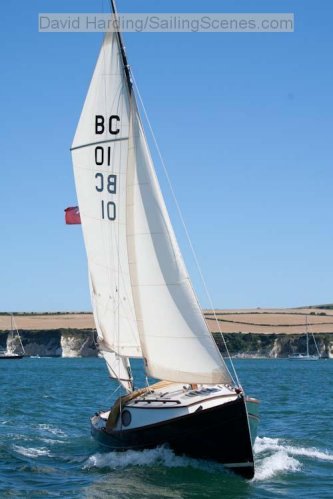This photo is a mosaic of two I took during the English Raid (can you spot the join?), looking down on Daisy G at low tide from the quayside at Keyhaven. I think is gives a very good view of the Baycruiser form. They are really quite beamy, although quite narrow at the waterline. This is partly why they have such high form stability. As soon as she starts to heel, a great chunk of the overhanging side is forced into the water and this in turn pushes buoyantly back. She is very stable even without the water ballast, but rock solid with it.
This photo, taken from the same quayside, shows a comparison between the original Bayraider (Simon Knight's fibreglass Carpe Diem in this case) and the Baycruiser. They really are quite different. The surrounding bulwark on the BC gives a really nicely enclosed foredeck. There is also no under-sidedeck stowage on the Bayraider, which is so useful on the Baycruiser (see the previous post to see the boathooks stored in this area). On the other hand, it has bigger under bench cockpit lockers on both sides plus a huge storage area under the foredeck. The original proposed cabin verison of the Bayraider was to have just a slightly raised and extended foredeck to form a "camping cuddy". I think there are still plans to pursue this. I wanted a full cabin to use as my Wendy house, as my wife describes it. Simon and I are convinced the Baycruiser is significantly longer than the Bayraider, more than the specified 5 inches, but we never got round to actually measuring them.
This angle also clearly shows the original and revised positions of the jib sheet fairlead tracks. The originals, on the cabin roof, were too close to the centreline, despite Matt insisting that they met all the theoretical design requirements. The new positions on the grab rails are a bit odd looking but work well. I am going to remove the original tracks over the winter.
Just to complete the comparison. This view gives an idea of the different cockpits of the Raider and Cruiser. The under side deck stowage shows up clearly. You can also see my stern ladder in its "deployed" position and the tiller control line, which hooks over a cleat on the under side. Knots in the line stop the tiller slipping and bungees at each end make it easy to whip on and off.
Just to complete the picture, this is the design that started it all, a Searaider, Pelham Olive's Lattis, tied up alongside Daisy G at Buckler's Hard. This is a racing boat with twin headsails on a permanent bowsprit, all sorts of adjustment tackles and a tiller controlled by tiller lines aorund the engine well. They even had trapeze wires. But... they had to sleep on board the Thames barge mother ship, whilst my daughter and I slept comfortably aboard Daisy Grace for five nights. Horses, or boats, for courses.
And finally (is there ever a finally) the one they are all talking about, the Bayraider 17, under sail and under tow. This is Matt Newland's own boat. I think it is a stunner. It is so sleek and simple inside. I see this as a big seller and a real replacement to the Drascombe Dabber, which was always my favourite.
The shed builder arrived on site this morning and started sawing bits of wood! Yay!
Subscribe to:
Post Comments (Atom)







Thanks for the photos. Really useful for someone contemplating one, which I am. One comment is that the outboard does seem to take up an awful lot of the cockpit. I would want it more out of the way, but I presume that is all you can do with the design as it is?
ReplyDeleteLooking at the area behind the mizzen, it looks like some wasted space that could be turned into storage for an outboard or is the tiller too much in the way?
The outboard retracts fully to create less drag, but this does mean it needs to be further forward than on other similar designs which are unable to kick up. On the plus side it is easy to reach and operate and available very quickly. In the down position it takes up less room, but you have to put up with the prop drag.
ReplyDeleteMatt
You got the definitive answer there! Matt's the designer. The space behind the mizzen is primarily bouyancy. It isn't such as volume as the tiller does run under it.
ReplyDeleteThe motor is a compromise. If it sticks down, it takes up less cockpit room, but causes drag. Up it takes up space, but you slip through the water. If you had a little 2.5HP outboard you could take it off and stick it in a locker. But you wouldn't have much reserve power in a head wind/current.
Thanks for the feedback Matt and the extra photos Julian. As always it's all about the compromise. I can see the advantages it offers, which I like. Having said that I think my observation still stands as a consideration when you want to take the family out for a day sail. Smaller engine stowed sounds like a solution.
ReplyDeleteRichard
Andrew Wolstenholme's Kite has a big cockpit and small cabin, if that is your type of sailing. but you will have to unship the engine as it doesn't tilt.
ReplyDeletehttp://lh6.ggpht.com/_mPSLZX0tGuI/TFhz_f-o_eI/AAAAAAAAAhg/9OGDz4v697U/s1600/englishraid%20037.jpg
One of the many good features of the Bayraider 20 is the cockpit size. Plenty of room for day sailing. I have had 4 adults with plenty of room to move and 14 when we went from a camp on an ice cream raid! the Baycruiser will be a delight for two but where would you put all those grandchildren and friends? I would like a small cabin but not at the expense of cockpit space
ReplyDelete